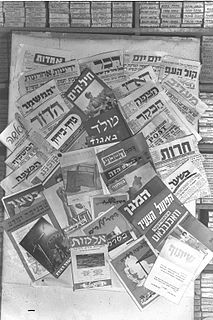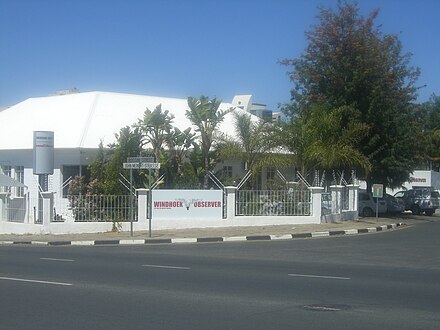Telecommunications in Namibia include radio, television, fixed and mobile telephones, and the Internet.

The media of South Africa has a large mass media sector and is one of Africa's major media centres. While South Africa's many broadcasters and publications reflect the diversity of the population as a whole, the most commonly used language is English. However, all ten other official languages are represented to some extent or another. Afrikaans is the second most commonly used language, especially in the publishing sector.

The mass media in Burkina Faso consists of print media and state-supported radio, news, and television stations, along with several private broadcasters with programs consisting of sports, music, cultural, or religious themes.
Media of Morocco includes newspapers, radio, television, and the Internet.

The Namibian Broadcasting Corporation is the public broadcaster of Namibia. It was established in 1979, under the name South West African Broadcasting Corporation.

The mass media in Israel refers to print, broadcast and online media available in the State of Israel. The country boasts dozens of newspapers, magazines, and radio stations, which play an important role by the press in political, social and cultural life and cater it to a modern, developed and literate society.

Media in Sierra Leone began when the first modern printing press in Africa arrived at the start of the 19th century. In the 1860s the country became a journalist hub for Africa with professional travelling to the country from across the continent. At the end of the 19th century the industry went into decline and when radio was introduced in the 1930s this became the primary communication media. Print media is not widely read in Sierra Leone, especially outside Freetown, partially due to the low levels of literacy in the country. In 2008 there were 15 daily newspapers in addition to those published weekly. Among newspaper readership young people are likely to read newspapers weekly and older people daily. The majority of newspapers are privately run and are often critical of the government.
The print, broadcast and online media of Burma has undergone strict censorship and regulation since the 1962 Burmese coup d'état. The constitution provides for freedom of speech and the press; however, the government prohibits the exercise of these rights in practice. Reporters Without Borders ranked Burma 174th out of 178 in its 2010 Press Freedom Index, ahead of just Iran, Turkmenistan, North Korea, and Eritrea. In 2015, Burma moved up to 144th place, ahead of many of its ASEAN neighbours such as Singapore, as a result of political changes in the country.

The mass media in Kyrgyzstan experience greater freedom compared to neighbouring countries in the region, and the constitution guarantees freedom of the press and prohibits censorship. However, the media are still restricted by the government. The OSCE issued a report on the ethical standards in print and online media of Kyrgyzstan.

Mass media in Kenya includes more than 91 FM stations, more than 64 free to view TV stations, and an unconfirmed number of print newspapers and magazines. Publications mainly use English as their primary language of communication, with some media houses employing Swahili. Vernacular or community-based languages are commonly used in broadcast media; mostly radio.
The media of Zimbabwe has been varying amounts of control by successive governments, coming under tight restriction in recent years by the government of Robert Mugabe, particularly during the growing economic and political crisis in the country. The Zimbabwean constitution promotes freedom of the media and expression, however this is hampered by interference and the implementation of strict media laws. In its 2008 report, Reporters Without Borders ranked the Zimbabwean media as 151st out of 173.

The Allgemeine Zeitung founded in 1916, is the oldest daily newspaper in Namibia and the only German-language daily in Africa of which survived World War I.
The mass media in Angola is primarily controlled by Angola's dominant political party, the People's Movement for the Liberation of Angola (MPLA), led by José Eduardo dos Santos, the country's president.
The media of Cameroon includes independent outlets. The nation has only one national newspaper, which is state owned.
Mass media in Chad is controlled by the government.

Mass media in the Democratic Republic of the Congo are both nationally and internationally state owned and operated.
Mass media in Ivory Coast is controlled by the government. Audiovisual communications are regulated by the Conseil national de la communication audiovisuelle (CNCA), an administrative arm of the national government.
The Media of South Sudan is underdeveloped compared to many other countries, including fellow East African states like Kenya, Tanzania, and Uganda. Poor transportation infrastructure and entrenched poverty in the country inhibit both the circulation of newspapers, particularly in states located far from the capital of Juba, and the ability of media outlets to maintain regular coverage of the entire country.
The media of Mauritania is undergoing a shift into a freer journalistic environment, while becoming increasingly open to private sector.
Media of Tanzania includes print, radio, television, and the Internet. The "Tanzania Communications Regulatory Act" of 2003 created the Tanzania Communications Regulatory Authority, which oversees broadcast licensing. The Media Council of Tanzania began in 1995.










